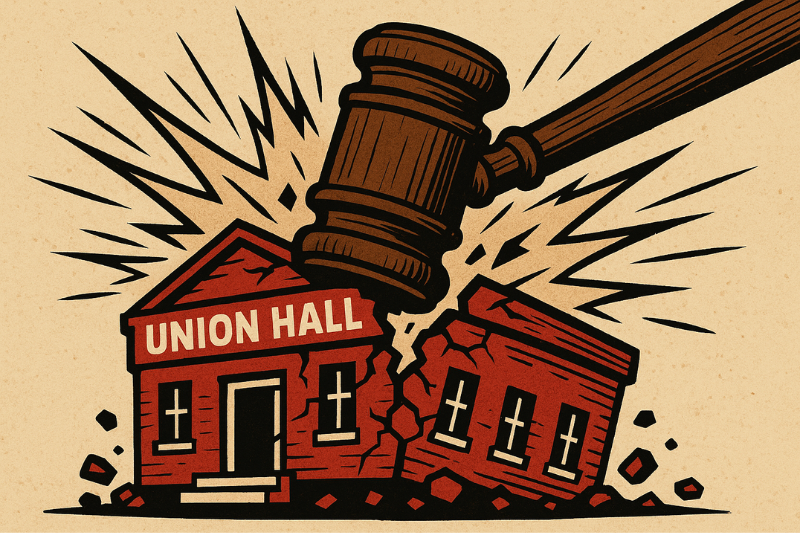In 2023, a Saskatchewan union recently paid nearly $300,000 in damages for botched representation, while unions across Canada successfully defend similar complaints daily. The difference isn’t about perfect outcomes — it’s about meeting basic standards of competence and fairness. Analysis of recent duty of fair representation (DFR) cases covered in HR Law Canada reveals some interesting patterns in what separates legitimate union judgment from conduct that crosses legal boundaries.
The legal test appears to be straightforward: unions breach their duty when they act “arbitrarily, discriminatorily or in bad faith.” But recent cases from HR Law Canada’s coverage show how tribunals apply this standard reveals crucial differences between unions that face massive damages and those that successfully defend their decisions.
Investigation quality separates winners from losers
The starkest difference between founded and dismissed DFR complaints lies in investigation quality before major decisions. In Waitson v International Brotherhood of Electrical Workers, Local 424, the Alberta Labour Relations Board found a DFR breach when the union conducted only a “cursory investigation” before deciding not to grieve a six-year employee’s termination.
The union failed to review essential documents, ignored disciplinary inconsistencies between workers involved in the same incident, and gave the terminated member no opportunity to respond.
“In the context of a termination of a six-year employee with no previous disciplinary record, it was incumbent on the Union to obtain full details of these matters so that it could properly put its mind to the merits of the claim,” the Board stated. The union’s assistant business manager received conflicting statements from electricians but never resolved the discrepancies or examined the Field Level Hazard Assessment.
Contrast this with Adjei v International Union of Operating Engineers, Local Union No. 955, where the Alberta Labour Relations Board dismissed a DFR complaint despite the employer’s refusal to share its full harassment investigation report. The union conducted its own investigation, interviewed witnesses, and produced a six-page analysis reviewing allegations and evidence. Even with limited information, the union’s effort to gather available facts and document its reasoning met legal standards.
The takeaway: unions don’t need perfect information, but they must make reasonable efforts to investigate before making consequential decisions about members’ employment.
Procedural failures versus strategic choices
The most expensive DFR breach in recent HR Law Canada coverage (the $300,000 ruling involving the Saskatchewan Government and General Employees Union mentioned above) shows how procedural incompetence differs from strategic decision-making. The Saskatchewan union “did nothing” to assist the member during critical meetings, showed up to arbitration without medical evidence despite claiming a medical defense, and couldn’t explain who made key decisions or why.
“Their course of conduct was so implausible, so summary and so reckless as to be unworthy of protection,” the Saskatchewan Labour Relations Board ruled, finding the union acted “arbitrarily, discriminatorily and in bad faith.”
The union shifted blame to the member for evidence-gathering, which the Board called “clearly and obviously false.”
Meanwhile, in Neal Ramchaitar v Amalgamated Transit Union, the Ontario tribunal dismissed a DFR complaint where the union made strategic choices about which grievances to pursue. The union negotiated a last chance agreement, conducted a reasoned assessment of arbitration prospects, and withdrew a grievance based on limited options under the agreement’s terms. The tribunal found these decisions reflected legitimate strategic judgment rather than arbitrary conduct.
This distinction matters: Strategic decisions receive significant deference from tribunals, while procedural incompetence triggers liability and damages.
Documentation and rationale requirements
Successful union defenses consistently feature documented decision-making processes and clear rationales. In dismissed DFR cases, unions could explain their reasoning: why they prioritized settlement over arbitration, how they assessed case prospects, what factors influenced tactical choices. Tribunals repeatedly emphasize they don’t evaluate whether union decisions were optimal, but whether the decision-making process was reasonable.
The failed representations share a common pattern: Unions couldn’t explain their rationale for key decisions or, in the Saskatchewan case, even identify who made important choices.
Financial consequences reflect conduct severity
Damage awards reflect the severity of union failures. The Saskatchewan case resulted in $294,755 in total damages, including $206,849 for the DFR breach itself and $25,000 in moral damages — the highest amount in Saskatchewan precedent that we’re aware of.
The Board noted the member was “particularly vulnerable” and the union had knowledge of that vulnerability, suggesting enhanced duties for unions dealing with members facing health issues or other complications.
Tribunals also consider whether union conduct was a single error versus systematic failure. The Saskatchewan case involved “fundamental contraventions” across investigation, preparation, and representation phases, while successful union defenses typically involve isolated strategic decisions within reasonable bounds.
Practical implications for workplace relations
These cases reveal several critical insights. First, unions operating with competent procedures and reasonable strategic frameworks successfully defend most DFR complaints, but procedural breakdowns and documented incompetence create significant liability exposure.
Second, disciplinary consistency matters — the Alberta electrician case partly hinged on why similar conduct received different punishments, suggesting employers should document rationales for disciplinary variations.
Third, vulnerable employees require enhanced attention from their unions, with tribunals showing less tolerance for representation failures affecting members with disabilities, health issues, or other complications. Finally, timing remains crucial: multiple cases involved dismissals for excessive delay, with tribunals measuring acceptable delay “in months, not years.”
The bottom line for workplace relationships: Unions receive substantial deference for strategic judgments but face serious consequences for procedural failures, documented incompetence, and arbitrary treatment of vulnerable members. Understanding this distinction helps professionals evaluate union conduct and anticipate potential DFR challenges.






